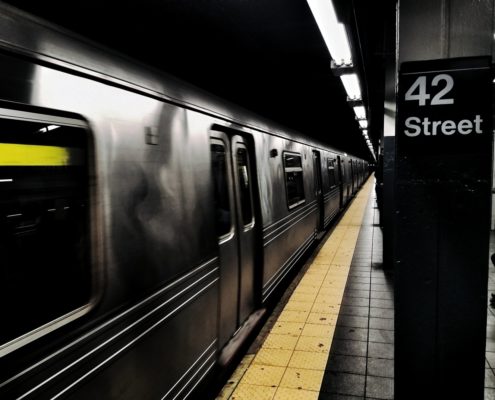The Importance of Tactile Warnings
An estimated 1.3 billion people worldwide are living with some degree of visual impairment, from moderate issues that can be corrected with glasses to total legal blindness.¹ In the United States alone, more than three million people are visually impaired.²
With so many people living with vision problems, we as a society have developed ways to make sure they get the same opportunities and respect that sighted people do. One especially valuable tool is what’s called a “tactile warning surface.”
What Are Tactile Warning Surfaces?
Tactile warnings—also known as ADA tactile surfaces, detectable warning surfaces, and other similar names—are specialized textured surfaces that help those with limited or no vision navigate by feel using their feet and/or a cane. The texture consists of a series of bumps in a “truncated dome” shape that’s both easily recognizable and safe to walk on.
Warning surfaces are available in a variety of colors, but installers very often choose a color that contrasts strongly with the surface the tiles will be anchored into. This high-contrast appearance helps the warnings stand out even more for people who still have some degree of sight.
Tactile warning tiles are also made from highly durable materials for a long lifespan even in areas of heavy foot traffic. ADA Solutions, for example, uses materials like carbon composite, fiberglass, and cast iron for sturdy results that resist wear for a very long time.
Types of Detectable Warning Products
Warning surfaces can be made in a variety of sizes and types. At ADA Solutions, we offer tiles in several standard sizes for flexible applications. We produce a few types of tiles with different installation methods and capabilities to suit various needs.
Standard cast-in-place tiles are meant to be installed while the surrounding surface is being constructed but cannot be replaced once they’re installed. Cast-in-place replaceable tiles are also meant to be installed during initial construction but are designed to be removed from their anchors and replaced with new surfaces over time.
Surface applied tactile warning tiles are meant to be used on existing surfaces, making them ideal for retrofit applications. If you’re tasked with bringing an existing area into ADA compliance, this type of tile allows you to correct any compliance issues without major reconstruction.
The Legal Requirements of the Americans with Disabilities Act
In 1990, President George H.W. Bush signed the Americans with Disabilities Act (ADA) into law, instigating numerous changes to buildings, walkways, and other spaces that would make things more accessible to individuals living with disabilities. Today, the U.S. Access Board continues to update and enforce ADA requirements for accessibility and fair treatment.
An example of the changes required by this law was the addition of “curb cuts,” the ramps that we see today wherever walkways intersect curbs. Covering these kinds of transitional areas with the truncated dome texture makes it much easier to feel the ramps than it would be if they were simply printed with a texture.
Failing to comply with ADA tactile warning requirements can have major repercussions. In addition to the potential for personal injury lawsuits, ADA violations can result in hefty fines. For a first violation, the penalty can be as high as $75,000. For additional violations, the maximum penalty jumps to $150,000.³ Of course, the actual penalty amount assessed will depend upon the type and severity of the violation.
Tactile Warnings Are Used All Around Us
Even if you have perfect vision, you may not have noticed just how many tactile surfaces are around you wherever you go. In fact, they’ve become so commonplace that it’s easy to simply overlook them. Take a look at a few of the most common places detectable warning surfaces can be found.
At the Ends of Crosswalks
ADA tactile surfaces are used to alert visually impaired pedestrians that they are about to enter or exit a crosswalk. This way, they know when they’ve left the sidewalk as well as when they’ve finished crossing. Once they feel the texture change again, they know they’ve reached the sidewalk on the other side.
In some areas, the entire crosswalk may be paved with detectable warning tiles. To stay inside the crosswalk in these cases, visually impaired individuals simply need to make sure they can feel the truncated dome surface.

At Sidewalk Curbs
In some areas, detectable warning surfaces are placed along the roadside edge of the sidewalk. These warnings are used to let visually impaired people know that they are nearing the edge of the curb and are close to the road. Without these warnings, people could find themselves at risk of injury from tripping over curbs or being struck by vehicles.
Along Unsafe Edges at Transit Stations
Like the warning surfaces used to indicate sidewalk curbs, tactile warning strips are required to be placed along the length of train/subway platforms and other potentially dangerous areas at transit stations. This helps protect visually impaired individuals against the risk of falling off the platform and onto the tracks.

In Parking Lots
Parking lots often don’t have clear curbs or separations between driver and pedestrian areas. To prevent accidents between drivers and visually impaired persons, businesses and public organizations can provide physical guidance with tactile warnings. When a visually impaired person feels the surface, they know they’re approaching an area where cars will be moving through the lot.
Around Water Features like Reflecting Pools
The need for detectable warning surfaces isn’t limited to sidewalks and roadways. The ADA also requires the use of tactile warnings around reflecting pools (like the one on the National Mall) so that visually impaired people won’t fall in.
Tactile Warning Surfaces Save Lives Every Day
Detectable warnings are a matter of life and death. Even a person with only mild visual impairment runs a higher risk of being hurt in an accident than those with an average level of sight. For those with severe vision loss, the ability to use other senses to navigate is absolutely essential to protecting them from accidentally walking into dangerous areas.
In a 2012 study, researchers found that individuals who were blind and could only hear their surroundings were not as accurate in their street-crossing decisions as their sighted and impaired counterparts.⁴ For these individuals, the inclusion of tactile warning surfaces could make all the difference.
Tactile Warnings Also Benefit Businesses and Communities
In addition to meeting legal requirements, state and local governments, communities, and commercial businesses can all benefit from the installation of tactile warning surfaces. Consider the following examples:
- A stronger focus on accessibility can help revitalize a community and send a clear message to prospective residents that they are strongly dedicated to the equitable treatment of people with disabilities.
- Retrofitting an older property with appropriate ADA-Compliant warning surfaces can make business parking lots safer, reducing liability risks and encouraging patronage by those with visual or other impairments.
- The bright visual cues presented by tactile warning surfaces can serve as an additional reminder to drivers that they should take care in those areas and watch carefully for pedestrians.
Protect Customers and Employees with Durable, ADA-Compliant Tactile Warning Surfaces from ADA Solutions
At ADA Solutions, we’re proud to say our heavy-duty, slip-resistant ADA tiles and wayfinding surfaces are the most trusted tactile warning products in the world. We manufacture and sell a variety of detectable warning tiles and systems to meet our customers’ many unique needs, from city improvements to retrofits for older business properties.
To learn more about our detectable warning surface products or request a free quote, call us today at (800) 372-0519.
Sources:
- https://www.who.int/news-room/fact-sheets/detail/blindness-and-visual-impairment
- https://www.nih.gov/news-events/news-releases/visual-impairment-blindness-cases-us-expected-double-2050
- https://www.ada.gov/civil_penalties_2014.htm
- https://www.ncbi.nlm.nih.gov/pmc/articles/PMC3358127/




